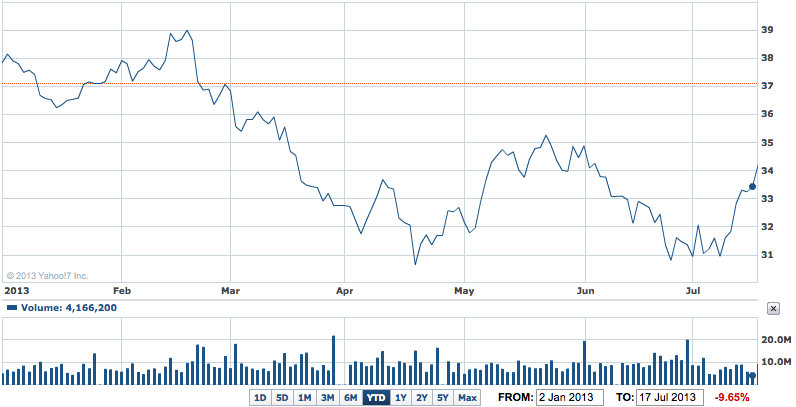After months of being the easy target for short sellers, hedge fund traders and market know-alls, especially when there’s weak economic news from China, Australia’s big three iron ore miners – BHP Billiton, Rio Tinto and Fortescue Metals Group – are back in the limelight and enjoyed nice rises yesterday.
The reason – better than expected production reports for the half year (Rio on Tuesday) and full year (BHP, yesterday), especially with iron ore going well.
On top of that both giants revealed better news on copper production and sales, and in the case of BHP, its US shale gas and oil businesses are doing well, along with its conventional oil and gas operations, and its coal mining operations produced better figures than expected by the market.
So for all the ‘expertise’ of a fleet of analysts, traders and those mythical ‘sources’ of gloomy forecasts, BHP and Rio have managed to outperform the market’s expectations and those bears looking for bad news out of China and regarding Australia and the likes of BHP and Rio as proxies for Chinese weakness, and therefore short selling targets for traders.
BHP shares rose 2.2% or 76c to to $34.19, Rio was up 63c or 1.1% to $56.15 and Fortescue was up 6% or 21c to $3.71.
BHP YTD – Strong production growth for BHP defies skeptics

As to how long this new found optimism lasts, no one can say – probably to the next bout of weaker than expected economic news from China – and drag those ‘experts from the darkness to sell their tales of doom and gloom.
Looking at BHP’s report yesterday for the 4th quarter and the full 12 months to June 30, we find that it beat its guidance for iron ore production, missed it in oil by a fraction, and did very well in copper, coal and several other sectors.
The company told the ASX that 4th quarter iron ore production rose 17% and helped deliver a 13th annual output record to 187 million tonnes (and a forecast of 183 million).
Output was 47.7 million tonnes in the three months ended June 30, a sharp rise from the 40.9 million tonnes a year earlier.
The 2013-14 target is 207 million tonnes, but in fact, the 4th quarter output was at an annual rate of 217 million tonnes which, if sustained, will mean a sharp rise in earnings from this division in the next year, even if iron ore prices dip.
The result compares with the 7% increase for rival, Rio Tinto’s iron ore output (which also beat estimates from the market).
Slowing Chinese GDP in the March and June quarters didn’t hurt BHP and Rio’s iron ore businesses as much as many analysts and hedge fund pessimists had feared (and in the case of BHP, slowing Chinese growth across its 2012-13 year didn’t have that big an impact).
BHP Billiton Production Report – Year Ended 30 June 2013
Despite the higher production from BHP and Rio, world iron ore prices have been firming and are up 13% in the past couple of weeks to around $US129 a tonne yesterday, which is much higher than anyone had thought they would be in this quarter.
The question now is whether the expected increases in production from BHP, Rio and Fortescue will push prices lower over the remainder of 2013?
And, while the news was not quite as good in BHP’s petroleum division, because drilling delays in the Gulf of Mexico saw full-year guidance narrowly missed, the company still managed to come close, producing 235.7 million barrels of oil equivalent (oil, gas and liquids). That included the company’s US shale businesses which produced 99 million barrels or oil equivalent in the year.
"The liquids rich Eagle Ford (US) is now Petroleum’s largest producing field as more than 100 new wells were brought online in the June 2013 quarter. Robust growth in Onshore US liquids production is anticipated again in the September 2013 quarter as additional wells are put online and infrastructure projects are completed," BHP said yesterday.
As well the company reported a "six per cent increase in natural gas production for the 2013 financial year reflected strong demand at Bass Strait (Australia), a full year of production from our Haynesville (US) dry gas field and associated gas volumes from the continued development of our liquids rich acreage in the Eagle Ford".
Copper saw a sharp improvement. Escondida, the world’s biggest copper mine in Chile (57% controlled by BHP) saw copper production increase 28% to 1.1 million tonnes in the 2013 financial year as the average copper grade mined rose to 1.4% and milling rates improved.
"This strong level of performance is expected to be sustained during the 2014 financial year before increasing to approximately 1.3 million tonnes (100 per cent basis) in the 2015 financial year," BHP said.
Total copper production increased by 10% in the 2013 financial year to 1.2 million tonnes.
Queensland coal production in the June 2013 quarter increased 54% from the prior corresponding period to an annualised rate of 61 million tonnes (100% basis) and all told, total metallurgical coal production increased 13% in the 2013 financial year to 38 million tonnes.
Total energy coal production increased 3% to 73 million tonnes. Mixed to solid gains were reported from some of the other businesses such as lead, silver and gold, zinc, diamonds and manganese.
BHP will report its full year financial result on August 20.
As a result of yesterday’s report, analysts reckon BHP will earn a net profit of around $US12.5 billion to $US13 billion in the year to June, down on the $US17.5 billion earned in 2011-12.













